University Business and Business Environment: BBC and ITV Analysis
VerifiedAdded on 2020/01/23
|22
|5481
|595
Report
AI Summary
This report provides a comprehensive analysis of the business environment, focusing on the British Broadcasting Corporation (BBC) and ITV. The study begins with an overview of both organizations, detailing their legal status, year of establishment, products/services, and objectives. Part 1 explores the size and scope of BBC and ITV, examining their employee numbers, annual turnover, market share, and product portfolios. The report then assesses the macro-environmental factors influencing ITV, employing a SWOT analysis to identify strengths, weaknesses, opportunities, and threats. The analysis links external macro factors with identified strengths and weaknesses, providing insights into how environmental factors influence business decisions. The report concludes with recommendations based on the findings.
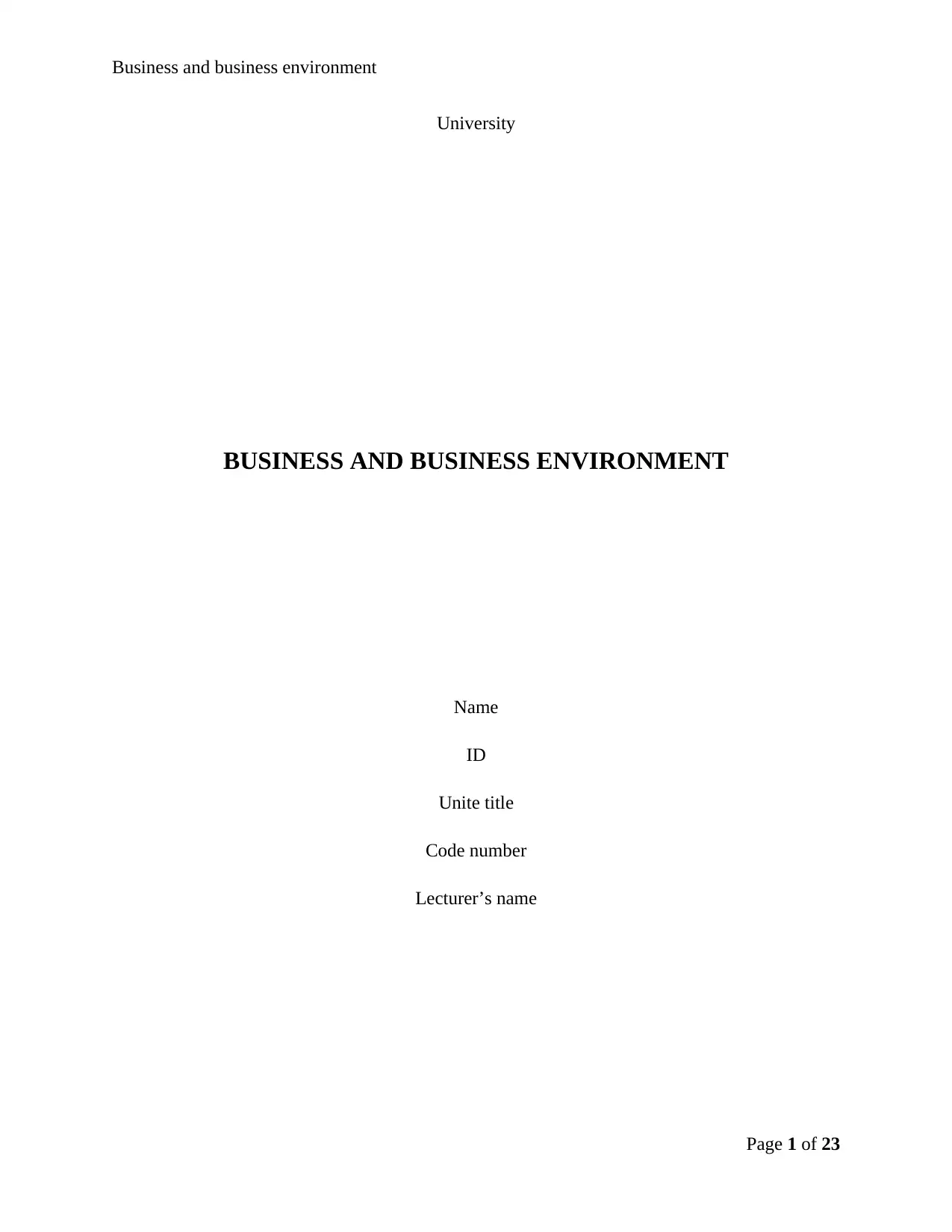
Business and business environment
University
BUSINESS AND BUSINESS ENVIRONMENT
Name
ID
Unite title
Code number
Lecturer’s name
Page 1 of 23
University
BUSINESS AND BUSINESS ENVIRONMENT
Name
ID
Unite title
Code number
Lecturer’s name
Page 1 of 23
Paraphrase This Document
Need a fresh take? Get an instant paraphrase of this document with our AI Paraphraser
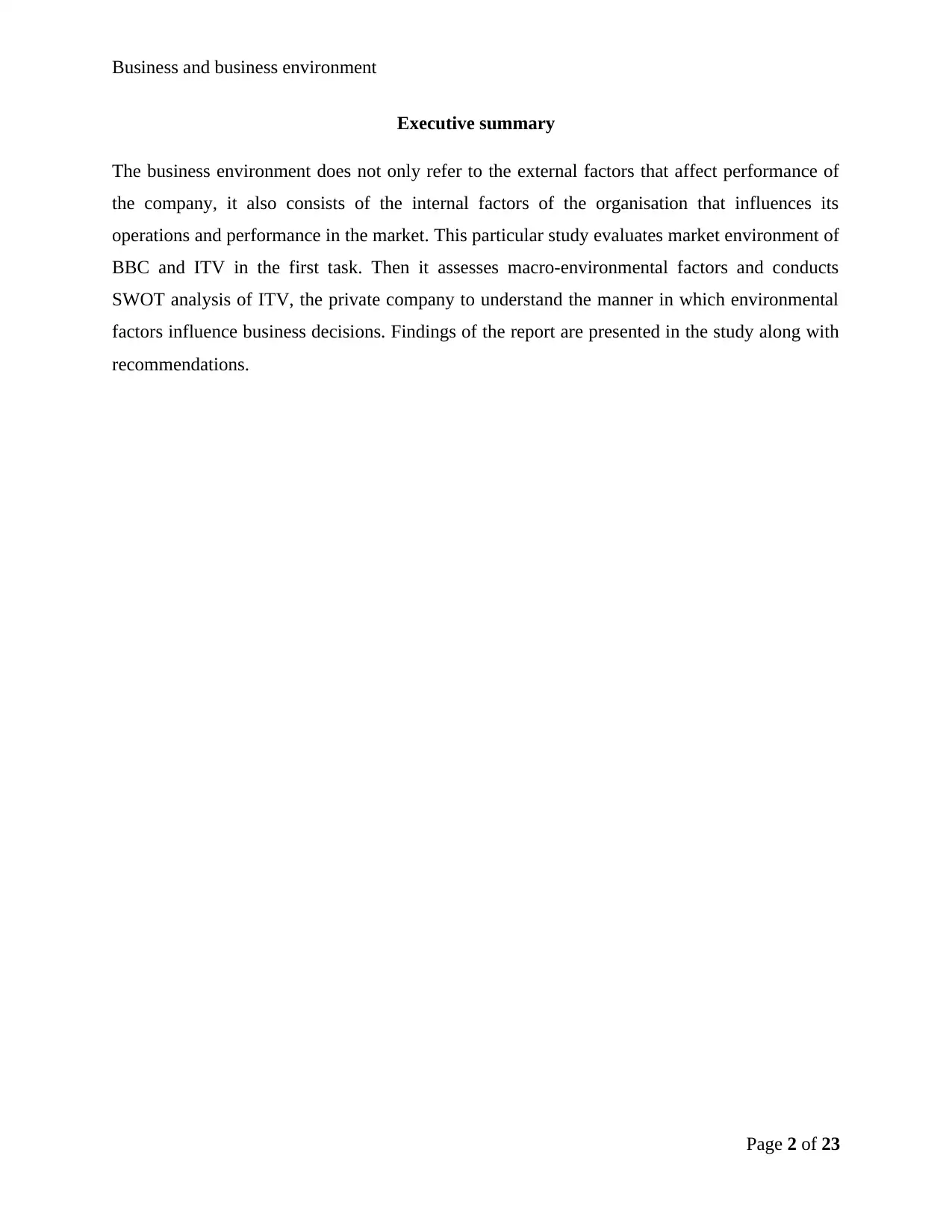
Business and business environment
Executive summary
The business environment does not only refer to the external factors that affect performance of
the company, it also consists of the internal factors of the organisation that influences its
operations and performance in the market. This particular study evaluates market environment of
BBC and ITV in the first task. Then it assesses macro-environmental factors and conducts
SWOT analysis of ITV, the private company to understand the manner in which environmental
factors influence business decisions. Findings of the report are presented in the study along with
recommendations.
Page 2 of 23
Executive summary
The business environment does not only refer to the external factors that affect performance of
the company, it also consists of the internal factors of the organisation that influences its
operations and performance in the market. This particular study evaluates market environment of
BBC and ITV in the first task. Then it assesses macro-environmental factors and conducts
SWOT analysis of ITV, the private company to understand the manner in which environmental
factors influence business decisions. Findings of the report are presented in the study along with
recommendations.
Page 2 of 23
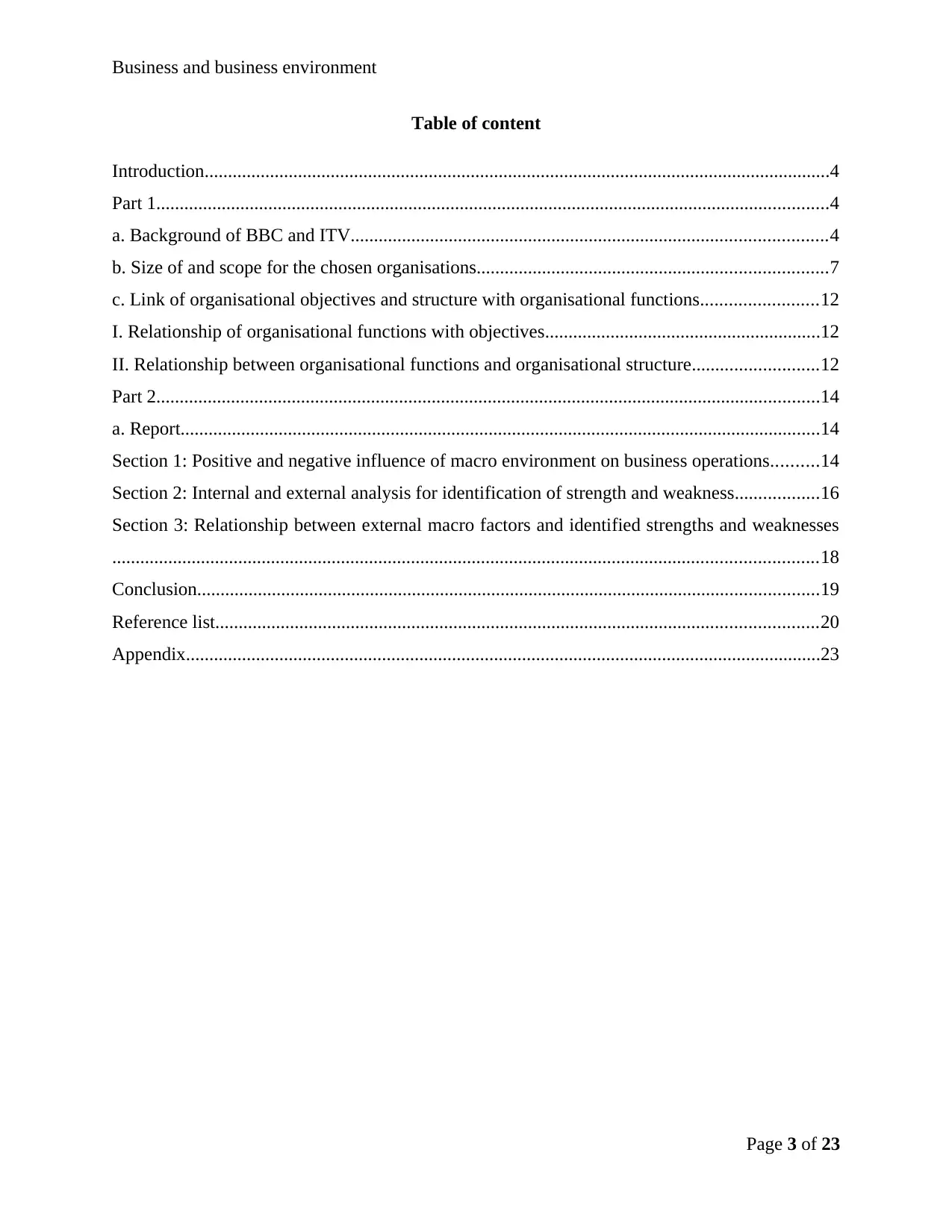
Business and business environment
Table of content
Introduction......................................................................................................................................4
Part 1................................................................................................................................................4
a. Background of BBC and ITV......................................................................................................4
b. Size of and scope for the chosen organisations...........................................................................7
c. Link of organisational objectives and structure with organisational functions.........................12
I. Relationship of organisational functions with objectives...........................................................12
II. Relationship between organisational functions and organisational structure...........................12
Part 2..............................................................................................................................................14
a. Report.........................................................................................................................................14
Section 1: Positive and negative influence of macro environment on business operations..........14
Section 2: Internal and external analysis for identification of strength and weakness..................16
Section 3: Relationship between external macro factors and identified strengths and weaknesses
.......................................................................................................................................................18
Conclusion.....................................................................................................................................19
Reference list.................................................................................................................................20
Appendix........................................................................................................................................23
Page 3 of 23
Table of content
Introduction......................................................................................................................................4
Part 1................................................................................................................................................4
a. Background of BBC and ITV......................................................................................................4
b. Size of and scope for the chosen organisations...........................................................................7
c. Link of organisational objectives and structure with organisational functions.........................12
I. Relationship of organisational functions with objectives...........................................................12
II. Relationship between organisational functions and organisational structure...........................12
Part 2..............................................................................................................................................14
a. Report.........................................................................................................................................14
Section 1: Positive and negative influence of macro environment on business operations..........14
Section 2: Internal and external analysis for identification of strength and weakness..................16
Section 3: Relationship between external macro factors and identified strengths and weaknesses
.......................................................................................................................................................18
Conclusion.....................................................................................................................................19
Reference list.................................................................................................................................20
Appendix........................................................................................................................................23
Page 3 of 23
⊘ This is a preview!⊘
Do you want full access?
Subscribe today to unlock all pages.

Trusted by 1+ million students worldwide
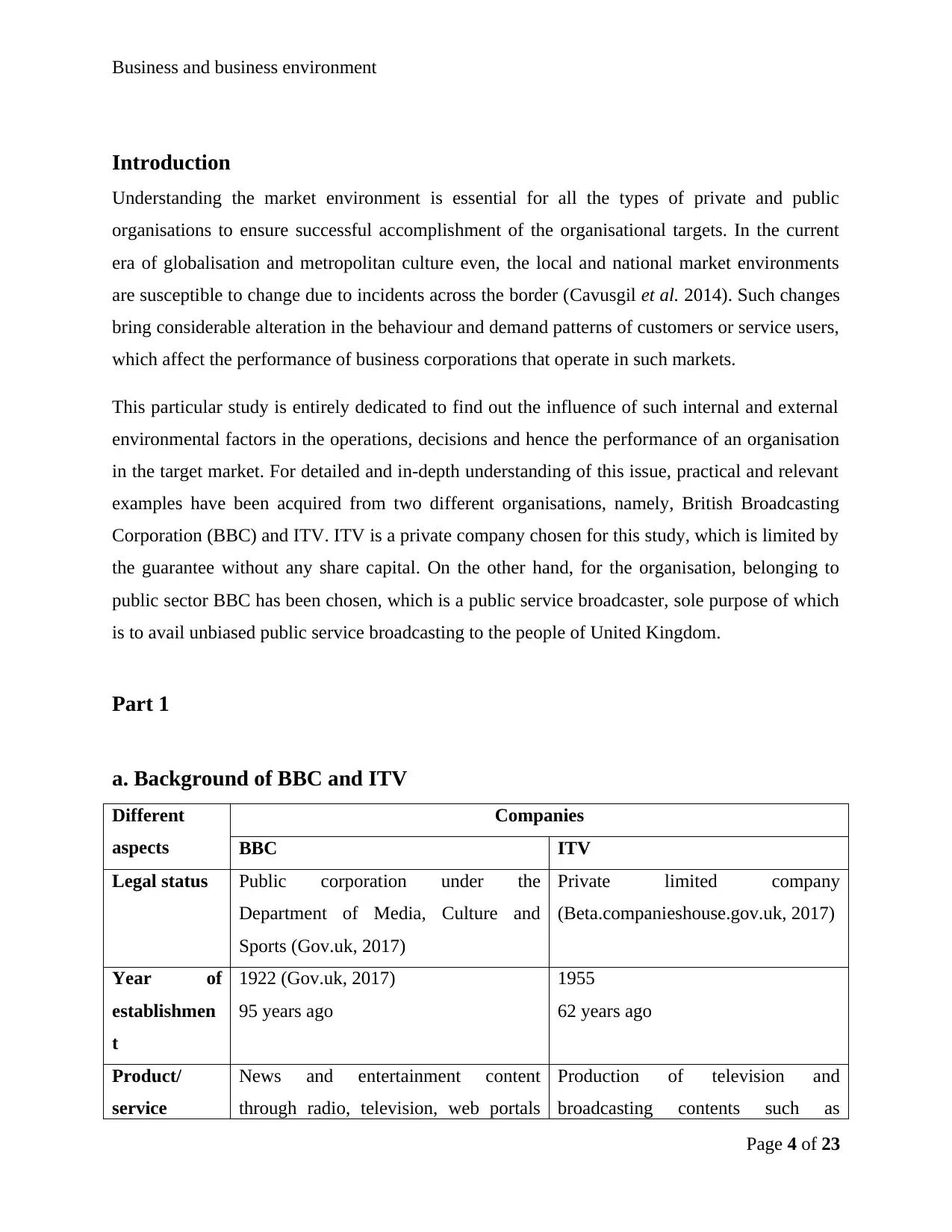
Business and business environment
Introduction
Understanding the market environment is essential for all the types of private and public
organisations to ensure successful accomplishment of the organisational targets. In the current
era of globalisation and metropolitan culture even, the local and national market environments
are susceptible to change due to incidents across the border (Cavusgil et al. 2014). Such changes
bring considerable alteration in the behaviour and demand patterns of customers or service users,
which affect the performance of business corporations that operate in such markets.
This particular study is entirely dedicated to find out the influence of such internal and external
environmental factors in the operations, decisions and hence the performance of an organisation
in the target market. For detailed and in-depth understanding of this issue, practical and relevant
examples have been acquired from two different organisations, namely, British Broadcasting
Corporation (BBC) and ITV. ITV is a private company chosen for this study, which is limited by
the guarantee without any share capital. On the other hand, for the organisation, belonging to
public sector BBC has been chosen, which is a public service broadcaster, sole purpose of which
is to avail unbiased public service broadcasting to the people of United Kingdom.
Part 1
a. Background of BBC and ITV
Different
aspects
Companies
BBC ITV
Legal status Public corporation under the
Department of Media, Culture and
Sports (Gov.uk, 2017)
Private limited company
(Beta.companieshouse.gov.uk, 2017)
Year of
establishmen
t
1922 (Gov.uk, 2017)
95 years ago
1955
62 years ago
Product/
service
News and entertainment content
through radio, television, web portals
Production of television and
broadcasting contents such as
Page 4 of 23
Introduction
Understanding the market environment is essential for all the types of private and public
organisations to ensure successful accomplishment of the organisational targets. In the current
era of globalisation and metropolitan culture even, the local and national market environments
are susceptible to change due to incidents across the border (Cavusgil et al. 2014). Such changes
bring considerable alteration in the behaviour and demand patterns of customers or service users,
which affect the performance of business corporations that operate in such markets.
This particular study is entirely dedicated to find out the influence of such internal and external
environmental factors in the operations, decisions and hence the performance of an organisation
in the target market. For detailed and in-depth understanding of this issue, practical and relevant
examples have been acquired from two different organisations, namely, British Broadcasting
Corporation (BBC) and ITV. ITV is a private company chosen for this study, which is limited by
the guarantee without any share capital. On the other hand, for the organisation, belonging to
public sector BBC has been chosen, which is a public service broadcaster, sole purpose of which
is to avail unbiased public service broadcasting to the people of United Kingdom.
Part 1
a. Background of BBC and ITV
Different
aspects
Companies
BBC ITV
Legal status Public corporation under the
Department of Media, Culture and
Sports (Gov.uk, 2017)
Private limited company
(Beta.companieshouse.gov.uk, 2017)
Year of
establishmen
t
1922 (Gov.uk, 2017)
95 years ago
1955
62 years ago
Product/
service
News and entertainment content
through radio, television, web portals
Production of television and
broadcasting contents such as
Page 4 of 23
Paraphrase This Document
Need a fresh take? Get an instant paraphrase of this document with our AI Paraphraser
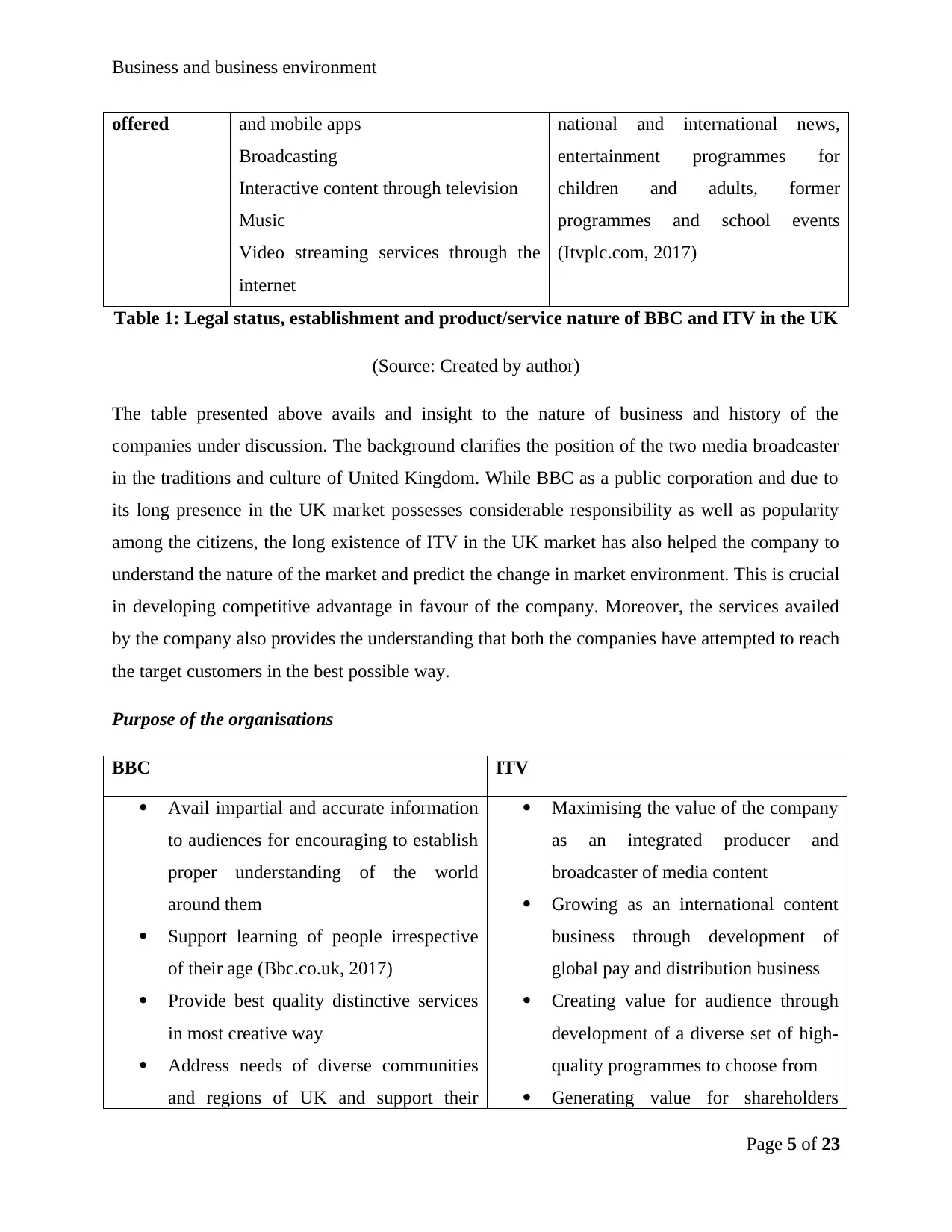
Business and business environment
offered and mobile apps
Broadcasting
Interactive content through television
Music
Video streaming services through the
internet
national and international news,
entertainment programmes for
children and adults, former
programmes and school events
(Itvplc.com, 2017)
Table 1: Legal status, establishment and product/service nature of BBC and ITV in the UK
(Source: Created by author)
The table presented above avails and insight to the nature of business and history of the
companies under discussion. The background clarifies the position of the two media broadcaster
in the traditions and culture of United Kingdom. While BBC as a public corporation and due to
its long presence in the UK market possesses considerable responsibility as well as popularity
among the citizens, the long existence of ITV in the UK market has also helped the company to
understand the nature of the market and predict the change in market environment. This is crucial
in developing competitive advantage in favour of the company. Moreover, the services availed
by the company also provides the understanding that both the companies have attempted to reach
the target customers in the best possible way.
Purpose of the organisations
BBC ITV
Avail impartial and accurate information
to audiences for encouraging to establish
proper understanding of the world
around them
Support learning of people irrespective
of their age (Bbc.co.uk, 2017)
Provide best quality distinctive services
in most creative way
Address needs of diverse communities
and regions of UK and support their
Maximising the value of the company
as an integrated producer and
broadcaster of media content
Growing as an international content
business through development of
global pay and distribution business
Creating value for audience through
development of a diverse set of high-
quality programmes to choose from
Generating value for shareholders
Page 5 of 23
offered and mobile apps
Broadcasting
Interactive content through television
Music
Video streaming services through the
internet
national and international news,
entertainment programmes for
children and adults, former
programmes and school events
(Itvplc.com, 2017)
Table 1: Legal status, establishment and product/service nature of BBC and ITV in the UK
(Source: Created by author)
The table presented above avails and insight to the nature of business and history of the
companies under discussion. The background clarifies the position of the two media broadcaster
in the traditions and culture of United Kingdom. While BBC as a public corporation and due to
its long presence in the UK market possesses considerable responsibility as well as popularity
among the citizens, the long existence of ITV in the UK market has also helped the company to
understand the nature of the market and predict the change in market environment. This is crucial
in developing competitive advantage in favour of the company. Moreover, the services availed
by the company also provides the understanding that both the companies have attempted to reach
the target customers in the best possible way.
Purpose of the organisations
BBC ITV
Avail impartial and accurate information
to audiences for encouraging to establish
proper understanding of the world
around them
Support learning of people irrespective
of their age (Bbc.co.uk, 2017)
Provide best quality distinctive services
in most creative way
Address needs of diverse communities
and regions of UK and support their
Maximising the value of the company
as an integrated producer and
broadcaster of media content
Growing as an international content
business through development of
global pay and distribution business
Creating value for audience through
development of a diverse set of high-
quality programmes to choose from
Generating value for shareholders
Page 5 of 23
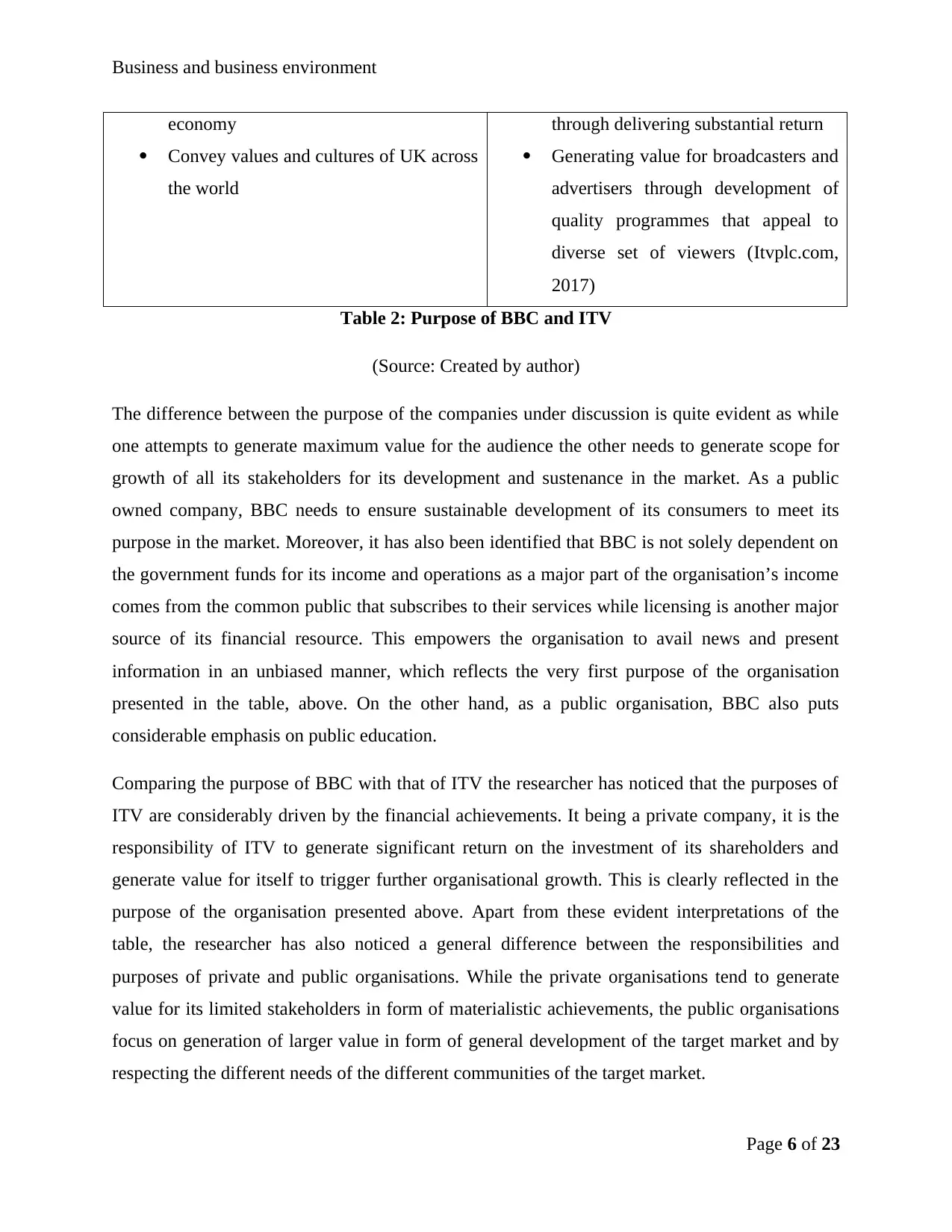
Business and business environment
economy
Convey values and cultures of UK across
the world
through delivering substantial return
Generating value for broadcasters and
advertisers through development of
quality programmes that appeal to
diverse set of viewers (Itvplc.com,
2017)
Table 2: Purpose of BBC and ITV
(Source: Created by author)
The difference between the purpose of the companies under discussion is quite evident as while
one attempts to generate maximum value for the audience the other needs to generate scope for
growth of all its stakeholders for its development and sustenance in the market. As a public
owned company, BBC needs to ensure sustainable development of its consumers to meet its
purpose in the market. Moreover, it has also been identified that BBC is not solely dependent on
the government funds for its income and operations as a major part of the organisation’s income
comes from the common public that subscribes to their services while licensing is another major
source of its financial resource. This empowers the organisation to avail news and present
information in an unbiased manner, which reflects the very first purpose of the organisation
presented in the table, above. On the other hand, as a public organisation, BBC also puts
considerable emphasis on public education.
Comparing the purpose of BBC with that of ITV the researcher has noticed that the purposes of
ITV are considerably driven by the financial achievements. It being a private company, it is the
responsibility of ITV to generate significant return on the investment of its shareholders and
generate value for itself to trigger further organisational growth. This is clearly reflected in the
purpose of the organisation presented above. Apart from these evident interpretations of the
table, the researcher has also noticed a general difference between the responsibilities and
purposes of private and public organisations. While the private organisations tend to generate
value for its limited stakeholders in form of materialistic achievements, the public organisations
focus on generation of larger value in form of general development of the target market and by
respecting the different needs of the different communities of the target market.
Page 6 of 23
economy
Convey values and cultures of UK across
the world
through delivering substantial return
Generating value for broadcasters and
advertisers through development of
quality programmes that appeal to
diverse set of viewers (Itvplc.com,
2017)
Table 2: Purpose of BBC and ITV
(Source: Created by author)
The difference between the purpose of the companies under discussion is quite evident as while
one attempts to generate maximum value for the audience the other needs to generate scope for
growth of all its stakeholders for its development and sustenance in the market. As a public
owned company, BBC needs to ensure sustainable development of its consumers to meet its
purpose in the market. Moreover, it has also been identified that BBC is not solely dependent on
the government funds for its income and operations as a major part of the organisation’s income
comes from the common public that subscribes to their services while licensing is another major
source of its financial resource. This empowers the organisation to avail news and present
information in an unbiased manner, which reflects the very first purpose of the organisation
presented in the table, above. On the other hand, as a public organisation, BBC also puts
considerable emphasis on public education.
Comparing the purpose of BBC with that of ITV the researcher has noticed that the purposes of
ITV are considerably driven by the financial achievements. It being a private company, it is the
responsibility of ITV to generate significant return on the investment of its shareholders and
generate value for itself to trigger further organisational growth. This is clearly reflected in the
purpose of the organisation presented above. Apart from these evident interpretations of the
table, the researcher has also noticed a general difference between the responsibilities and
purposes of private and public organisations. While the private organisations tend to generate
value for its limited stakeholders in form of materialistic achievements, the public organisations
focus on generation of larger value in form of general development of the target market and by
respecting the different needs of the different communities of the target market.
Page 6 of 23
⊘ This is a preview!⊘
Do you want full access?
Subscribe today to unlock all pages.

Trusted by 1+ million students worldwide
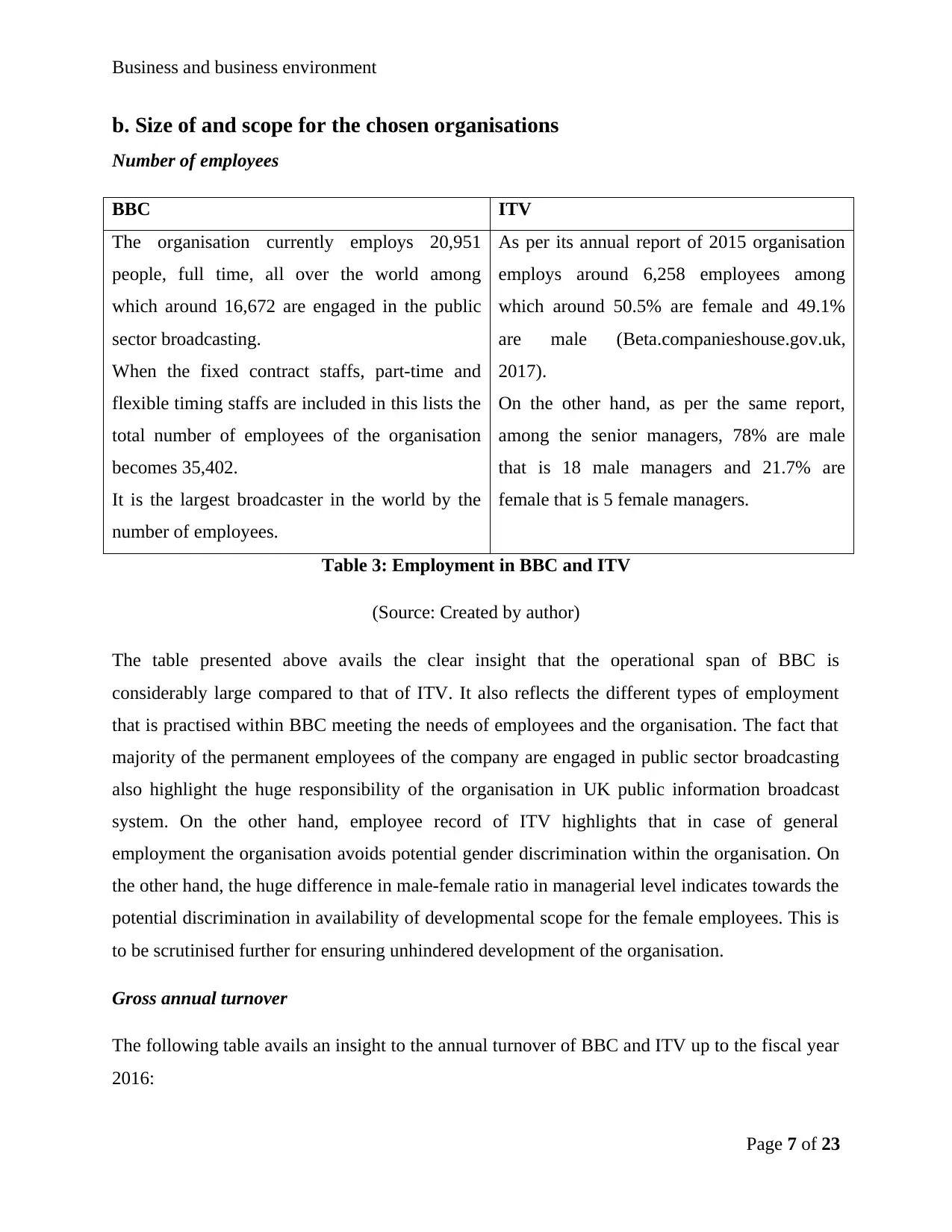
Business and business environment
b. Size of and scope for the chosen organisations
Number of employees
BBC ITV
The organisation currently employs 20,951
people, full time, all over the world among
which around 16,672 are engaged in the public
sector broadcasting.
When the fixed contract staffs, part-time and
flexible timing staffs are included in this lists the
total number of employees of the organisation
becomes 35,402.
It is the largest broadcaster in the world by the
number of employees.
As per its annual report of 2015 organisation
employs around 6,258 employees among
which around 50.5% are female and 49.1%
are male (Beta.companieshouse.gov.uk,
2017).
On the other hand, as per the same report,
among the senior managers, 78% are male
that is 18 male managers and 21.7% are
female that is 5 female managers.
Table 3: Employment in BBC and ITV
(Source: Created by author)
The table presented above avails the clear insight that the operational span of BBC is
considerably large compared to that of ITV. It also reflects the different types of employment
that is practised within BBC meeting the needs of employees and the organisation. The fact that
majority of the permanent employees of the company are engaged in public sector broadcasting
also highlight the huge responsibility of the organisation in UK public information broadcast
system. On the other hand, employee record of ITV highlights that in case of general
employment the organisation avoids potential gender discrimination within the organisation. On
the other hand, the huge difference in male-female ratio in managerial level indicates towards the
potential discrimination in availability of developmental scope for the female employees. This is
to be scrutinised further for ensuring unhindered development of the organisation.
Gross annual turnover
The following table avails an insight to the annual turnover of BBC and ITV up to the fiscal year
2016:
Page 7 of 23
b. Size of and scope for the chosen organisations
Number of employees
BBC ITV
The organisation currently employs 20,951
people, full time, all over the world among
which around 16,672 are engaged in the public
sector broadcasting.
When the fixed contract staffs, part-time and
flexible timing staffs are included in this lists the
total number of employees of the organisation
becomes 35,402.
It is the largest broadcaster in the world by the
number of employees.
As per its annual report of 2015 organisation
employs around 6,258 employees among
which around 50.5% are female and 49.1%
are male (Beta.companieshouse.gov.uk,
2017).
On the other hand, as per the same report,
among the senior managers, 78% are male
that is 18 male managers and 21.7% are
female that is 5 female managers.
Table 3: Employment in BBC and ITV
(Source: Created by author)
The table presented above avails the clear insight that the operational span of BBC is
considerably large compared to that of ITV. It also reflects the different types of employment
that is practised within BBC meeting the needs of employees and the organisation. The fact that
majority of the permanent employees of the company are engaged in public sector broadcasting
also highlight the huge responsibility of the organisation in UK public information broadcast
system. On the other hand, employee record of ITV highlights that in case of general
employment the organisation avoids potential gender discrimination within the organisation. On
the other hand, the huge difference in male-female ratio in managerial level indicates towards the
potential discrimination in availability of developmental scope for the female employees. This is
to be scrutinised further for ensuring unhindered development of the organisation.
Gross annual turnover
The following table avails an insight to the annual turnover of BBC and ITV up to the fiscal year
2016:
Page 7 of 23
Paraphrase This Document
Need a fresh take? Get an instant paraphrase of this document with our AI Paraphraser
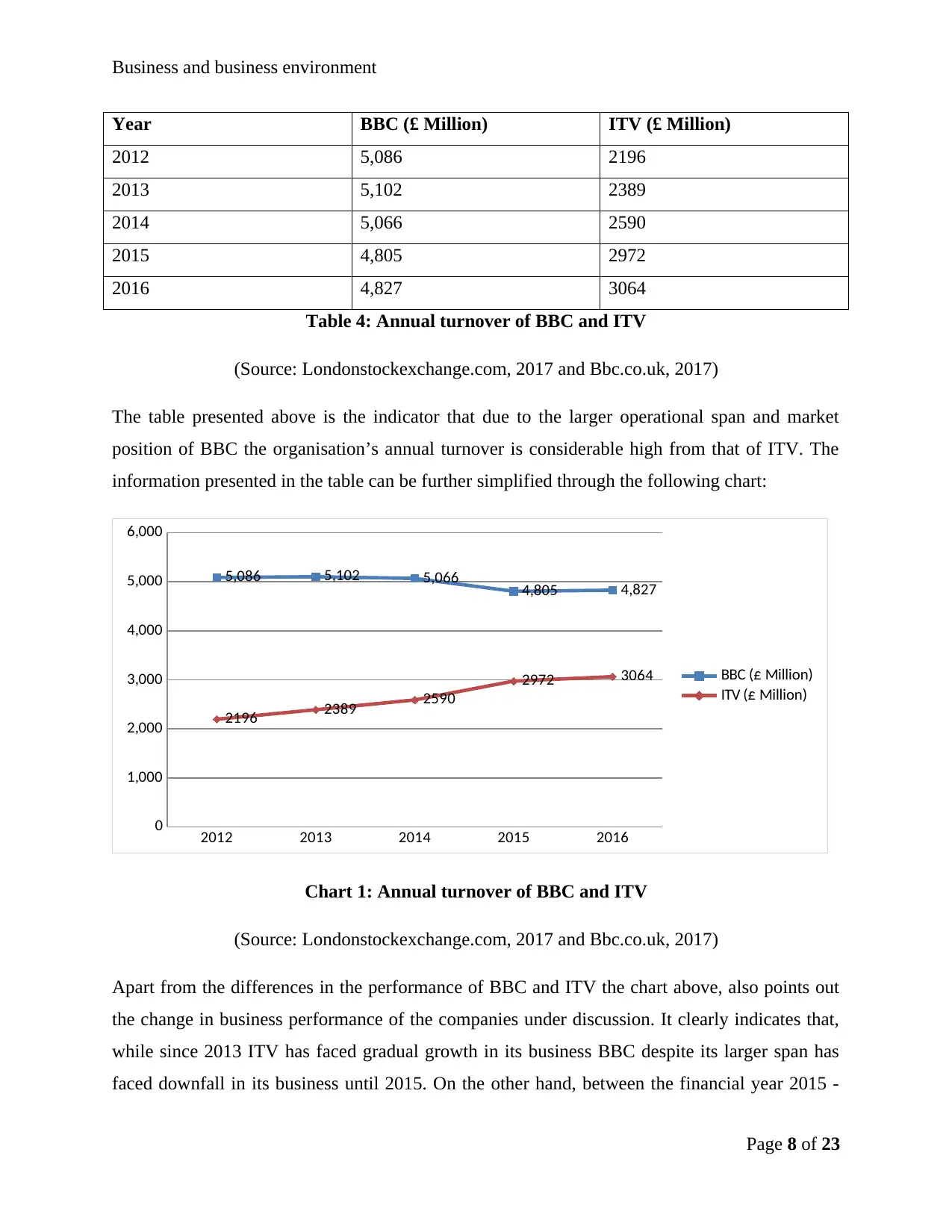
Business and business environment
Year BBC (£ Million) ITV (£ Million)
2012 5,086 2196
2013 5,102 2389
2014 5,066 2590
2015 4,805 2972
2016 4,827 3064
Table 4: Annual turnover of BBC and ITV
(Source: Londonstockexchange.com, 2017 and Bbc.co.uk, 2017)
The table presented above is the indicator that due to the larger operational span and market
position of BBC the organisation’s annual turnover is considerable high from that of ITV. The
information presented in the table can be further simplified through the following chart:
2012 2013 2014 2015 2016
0
1,000
2,000
3,000
4,000
5,000
6,000
5,086 5,102 5,066 4,805 4,827
2196 2389 2590
2972 3064 BBC (£ Million)
ITV (£ Million)
Chart 1: Annual turnover of BBC and ITV
(Source: Londonstockexchange.com, 2017 and Bbc.co.uk, 2017)
Apart from the differences in the performance of BBC and ITV the chart above, also points out
the change in business performance of the companies under discussion. It clearly indicates that,
while since 2013 ITV has faced gradual growth in its business BBC despite its larger span has
faced downfall in its business until 2015. On the other hand, between the financial year 2015 -
Page 8 of 23
Year BBC (£ Million) ITV (£ Million)
2012 5,086 2196
2013 5,102 2389
2014 5,066 2590
2015 4,805 2972
2016 4,827 3064
Table 4: Annual turnover of BBC and ITV
(Source: Londonstockexchange.com, 2017 and Bbc.co.uk, 2017)
The table presented above is the indicator that due to the larger operational span and market
position of BBC the organisation’s annual turnover is considerable high from that of ITV. The
information presented in the table can be further simplified through the following chart:
2012 2013 2014 2015 2016
0
1,000
2,000
3,000
4,000
5,000
6,000
5,086 5,102 5,066 4,805 4,827
2196 2389 2590
2972 3064 BBC (£ Million)
ITV (£ Million)
Chart 1: Annual turnover of BBC and ITV
(Source: Londonstockexchange.com, 2017 and Bbc.co.uk, 2017)
Apart from the differences in the performance of BBC and ITV the chart above, also points out
the change in business performance of the companies under discussion. It clearly indicates that,
while since 2013 ITV has faced gradual growth in its business BBC despite its larger span has
faced downfall in its business until 2015. On the other hand, between the financial year 2015 -
Page 8 of 23
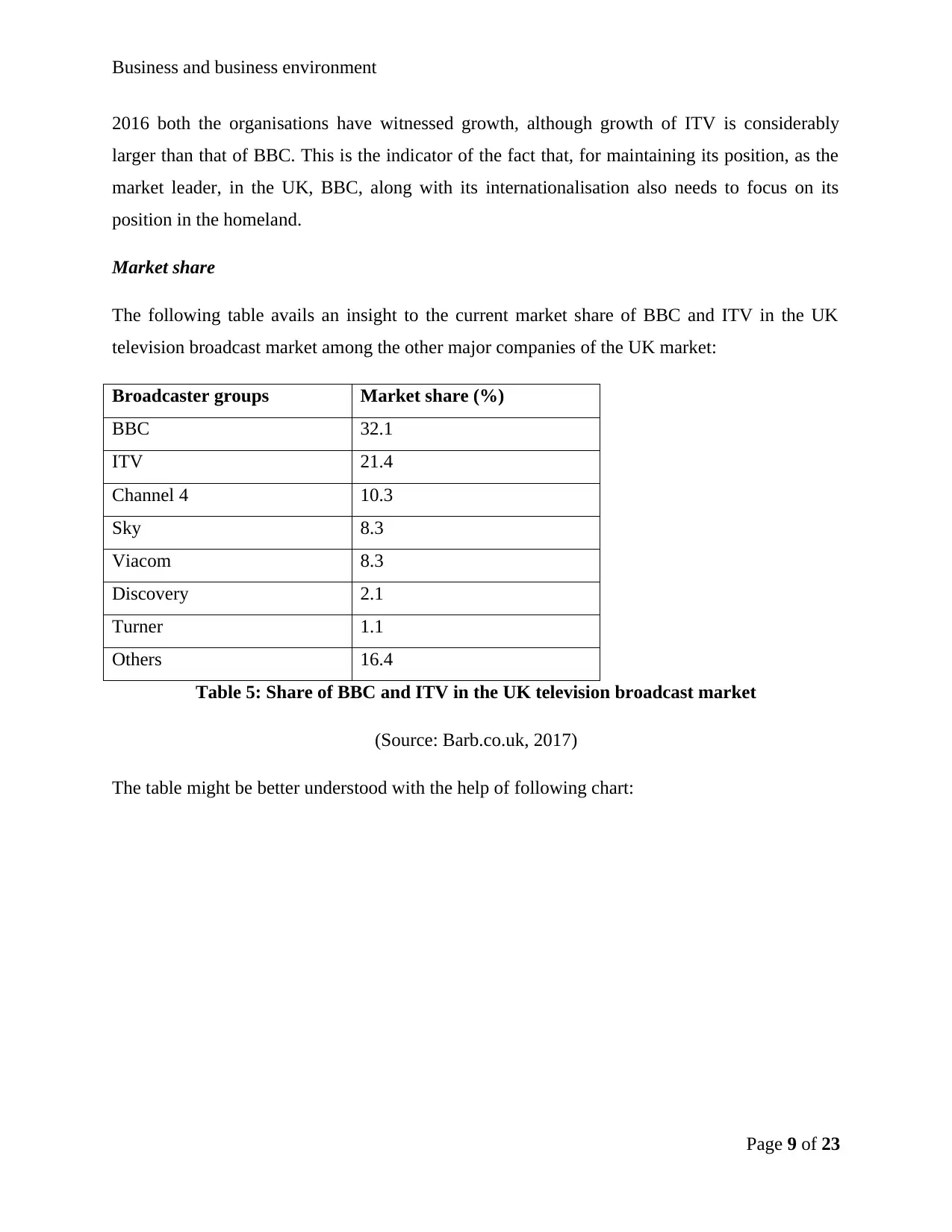
Business and business environment
2016 both the organisations have witnessed growth, although growth of ITV is considerably
larger than that of BBC. This is the indicator of the fact that, for maintaining its position, as the
market leader, in the UK, BBC, along with its internationalisation also needs to focus on its
position in the homeland.
Market share
The following table avails an insight to the current market share of BBC and ITV in the UK
television broadcast market among the other major companies of the UK market:
Broadcaster groups Market share (%)
BBC 32.1
ITV 21.4
Channel 4 10.3
Sky 8.3
Viacom 8.3
Discovery 2.1
Turner 1.1
Others 16.4
Table 5: Share of BBC and ITV in the UK television broadcast market
(Source: Barb.co.uk, 2017)
The table might be better understood with the help of following chart:
Page 9 of 23
2016 both the organisations have witnessed growth, although growth of ITV is considerably
larger than that of BBC. This is the indicator of the fact that, for maintaining its position, as the
market leader, in the UK, BBC, along with its internationalisation also needs to focus on its
position in the homeland.
Market share
The following table avails an insight to the current market share of BBC and ITV in the UK
television broadcast market among the other major companies of the UK market:
Broadcaster groups Market share (%)
BBC 32.1
ITV 21.4
Channel 4 10.3
Sky 8.3
Viacom 8.3
Discovery 2.1
Turner 1.1
Others 16.4
Table 5: Share of BBC and ITV in the UK television broadcast market
(Source: Barb.co.uk, 2017)
The table might be better understood with the help of following chart:
Page 9 of 23
⊘ This is a preview!⊘
Do you want full access?
Subscribe today to unlock all pages.

Trusted by 1+ million students worldwide
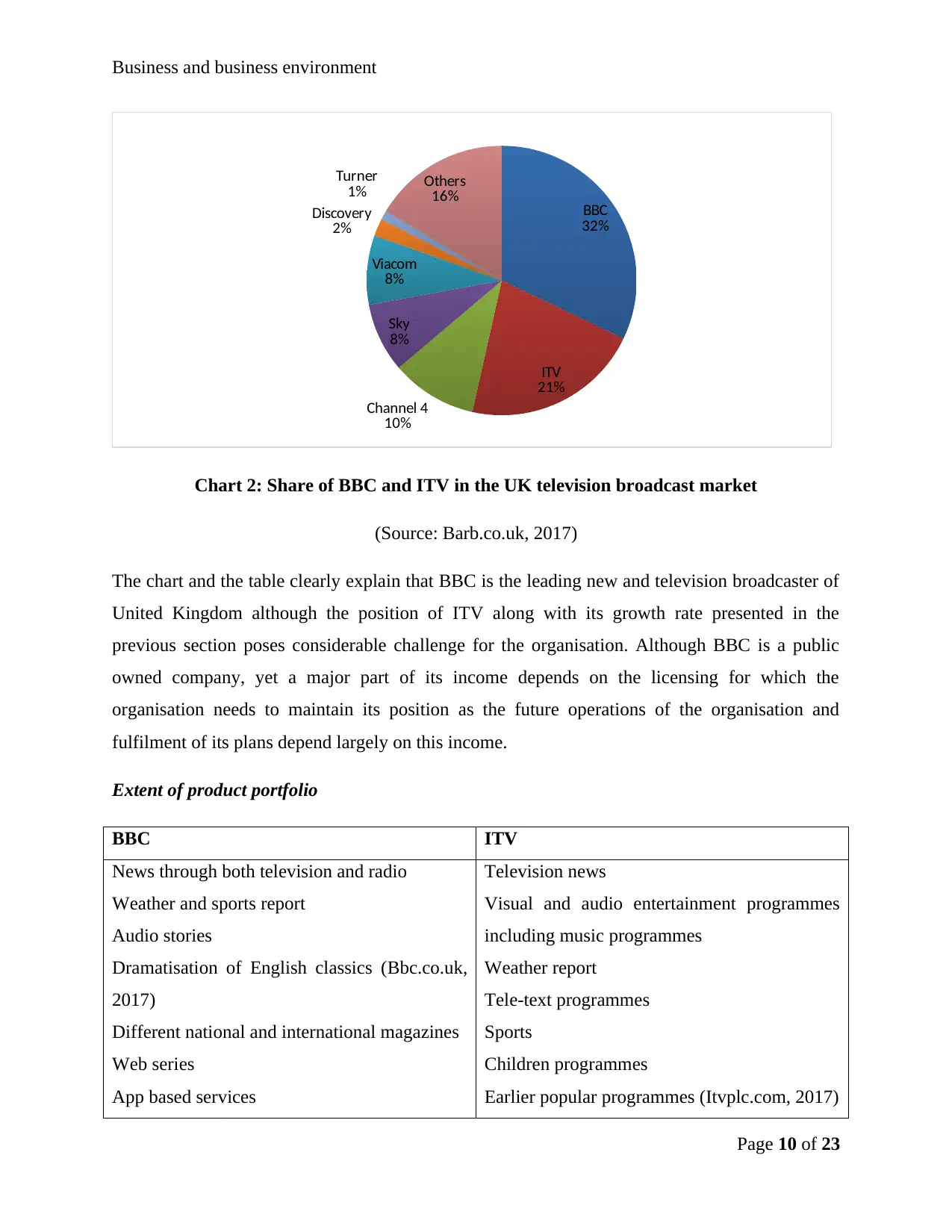
Business and business environment
BBC
32%
ITV
21%
Channel 4
10%
Sky
8%
Viacom
8%
Discovery
2%
Turner
1% Others
16%
Chart 2: Share of BBC and ITV in the UK television broadcast market
(Source: Barb.co.uk, 2017)
The chart and the table clearly explain that BBC is the leading new and television broadcaster of
United Kingdom although the position of ITV along with its growth rate presented in the
previous section poses considerable challenge for the organisation. Although BBC is a public
owned company, yet a major part of its income depends on the licensing for which the
organisation needs to maintain its position as the future operations of the organisation and
fulfilment of its plans depend largely on this income.
Extent of product portfolio
BBC ITV
News through both television and radio
Weather and sports report
Audio stories
Dramatisation of English classics (Bbc.co.uk,
2017)
Different national and international magazines
Web series
App based services
Television news
Visual and audio entertainment programmes
including music programmes
Weather report
Tele-text programmes
Sports
Children programmes
Earlier popular programmes (Itvplc.com, 2017)
Page 10 of 23
BBC
32%
ITV
21%
Channel 4
10%
Sky
8%
Viacom
8%
Discovery
2%
Turner
1% Others
16%
Chart 2: Share of BBC and ITV in the UK television broadcast market
(Source: Barb.co.uk, 2017)
The chart and the table clearly explain that BBC is the leading new and television broadcaster of
United Kingdom although the position of ITV along with its growth rate presented in the
previous section poses considerable challenge for the organisation. Although BBC is a public
owned company, yet a major part of its income depends on the licensing for which the
organisation needs to maintain its position as the future operations of the organisation and
fulfilment of its plans depend largely on this income.
Extent of product portfolio
BBC ITV
News through both television and radio
Weather and sports report
Audio stories
Dramatisation of English classics (Bbc.co.uk,
2017)
Different national and international magazines
Web series
App based services
Television news
Visual and audio entertainment programmes
including music programmes
Weather report
Tele-text programmes
Sports
Children programmes
Earlier popular programmes (Itvplc.com, 2017)
Page 10 of 23
Paraphrase This Document
Need a fresh take? Get an instant paraphrase of this document with our AI Paraphraser
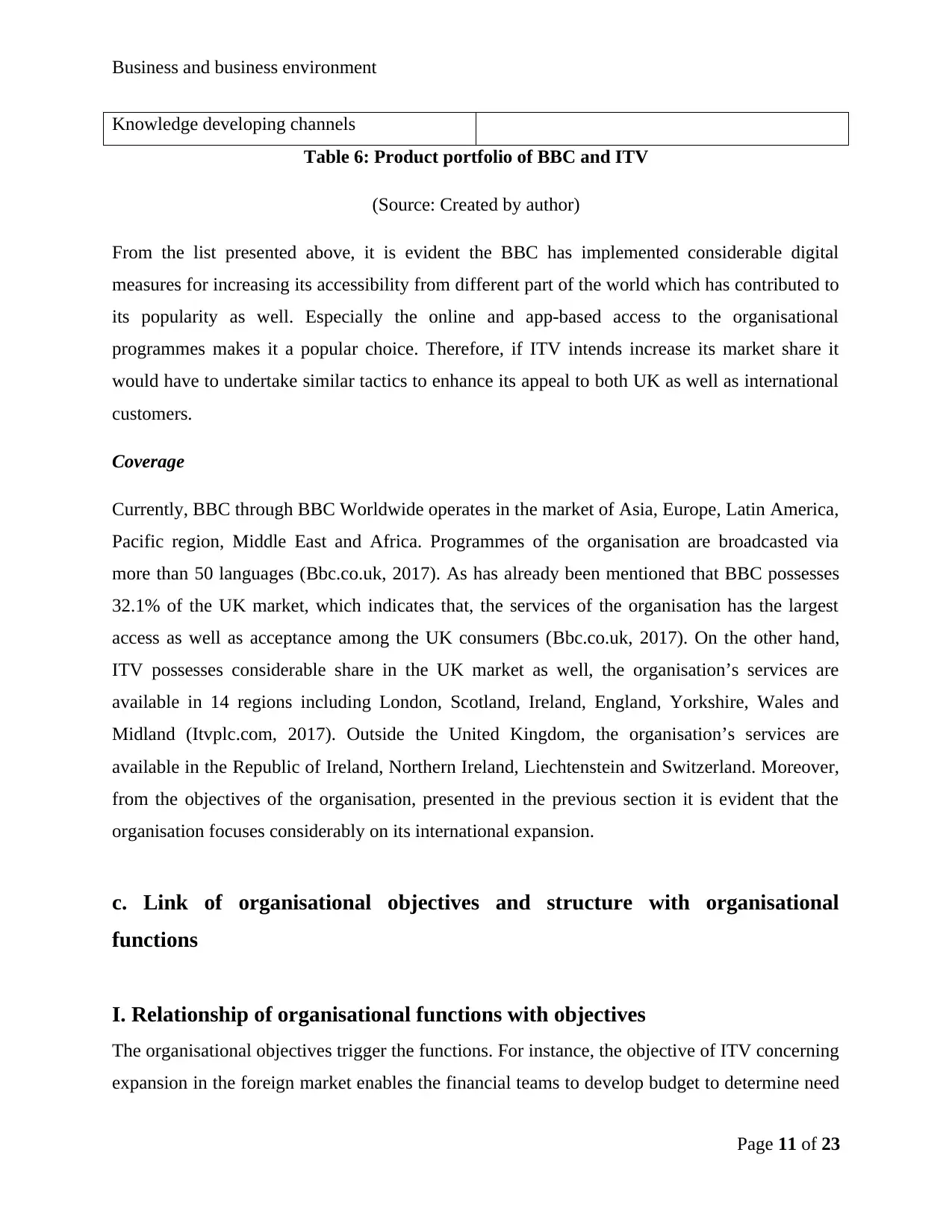
Business and business environment
Knowledge developing channels
Table 6: Product portfolio of BBC and ITV
(Source: Created by author)
From the list presented above, it is evident the BBC has implemented considerable digital
measures for increasing its accessibility from different part of the world which has contributed to
its popularity as well. Especially the online and app-based access to the organisational
programmes makes it a popular choice. Therefore, if ITV intends increase its market share it
would have to undertake similar tactics to enhance its appeal to both UK as well as international
customers.
Coverage
Currently, BBC through BBC Worldwide operates in the market of Asia, Europe, Latin America,
Pacific region, Middle East and Africa. Programmes of the organisation are broadcasted via
more than 50 languages (Bbc.co.uk, 2017). As has already been mentioned that BBC possesses
32.1% of the UK market, which indicates that, the services of the organisation has the largest
access as well as acceptance among the UK consumers (Bbc.co.uk, 2017). On the other hand,
ITV possesses considerable share in the UK market as well, the organisation’s services are
available in 14 regions including London, Scotland, Ireland, England, Yorkshire, Wales and
Midland (Itvplc.com, 2017). Outside the United Kingdom, the organisation’s services are
available in the Republic of Ireland, Northern Ireland, Liechtenstein and Switzerland. Moreover,
from the objectives of the organisation, presented in the previous section it is evident that the
organisation focuses considerably on its international expansion.
c. Link of organisational objectives and structure with organisational
functions
I. Relationship of organisational functions with objectives
The organisational objectives trigger the functions. For instance, the objective of ITV concerning
expansion in the foreign market enables the financial teams to develop budget to determine need
Page 11 of 23
Knowledge developing channels
Table 6: Product portfolio of BBC and ITV
(Source: Created by author)
From the list presented above, it is evident the BBC has implemented considerable digital
measures for increasing its accessibility from different part of the world which has contributed to
its popularity as well. Especially the online and app-based access to the organisational
programmes makes it a popular choice. Therefore, if ITV intends increase its market share it
would have to undertake similar tactics to enhance its appeal to both UK as well as international
customers.
Coverage
Currently, BBC through BBC Worldwide operates in the market of Asia, Europe, Latin America,
Pacific region, Middle East and Africa. Programmes of the organisation are broadcasted via
more than 50 languages (Bbc.co.uk, 2017). As has already been mentioned that BBC possesses
32.1% of the UK market, which indicates that, the services of the organisation has the largest
access as well as acceptance among the UK consumers (Bbc.co.uk, 2017). On the other hand,
ITV possesses considerable share in the UK market as well, the organisation’s services are
available in 14 regions including London, Scotland, Ireland, England, Yorkshire, Wales and
Midland (Itvplc.com, 2017). Outside the United Kingdom, the organisation’s services are
available in the Republic of Ireland, Northern Ireland, Liechtenstein and Switzerland. Moreover,
from the objectives of the organisation, presented in the previous section it is evident that the
organisation focuses considerably on its international expansion.
c. Link of organisational objectives and structure with organisational
functions
I. Relationship of organisational functions with objectives
The organisational objectives trigger the functions. For instance, the objective of ITV concerning
expansion in the foreign market enables the financial teams to develop budget to determine need
Page 11 of 23
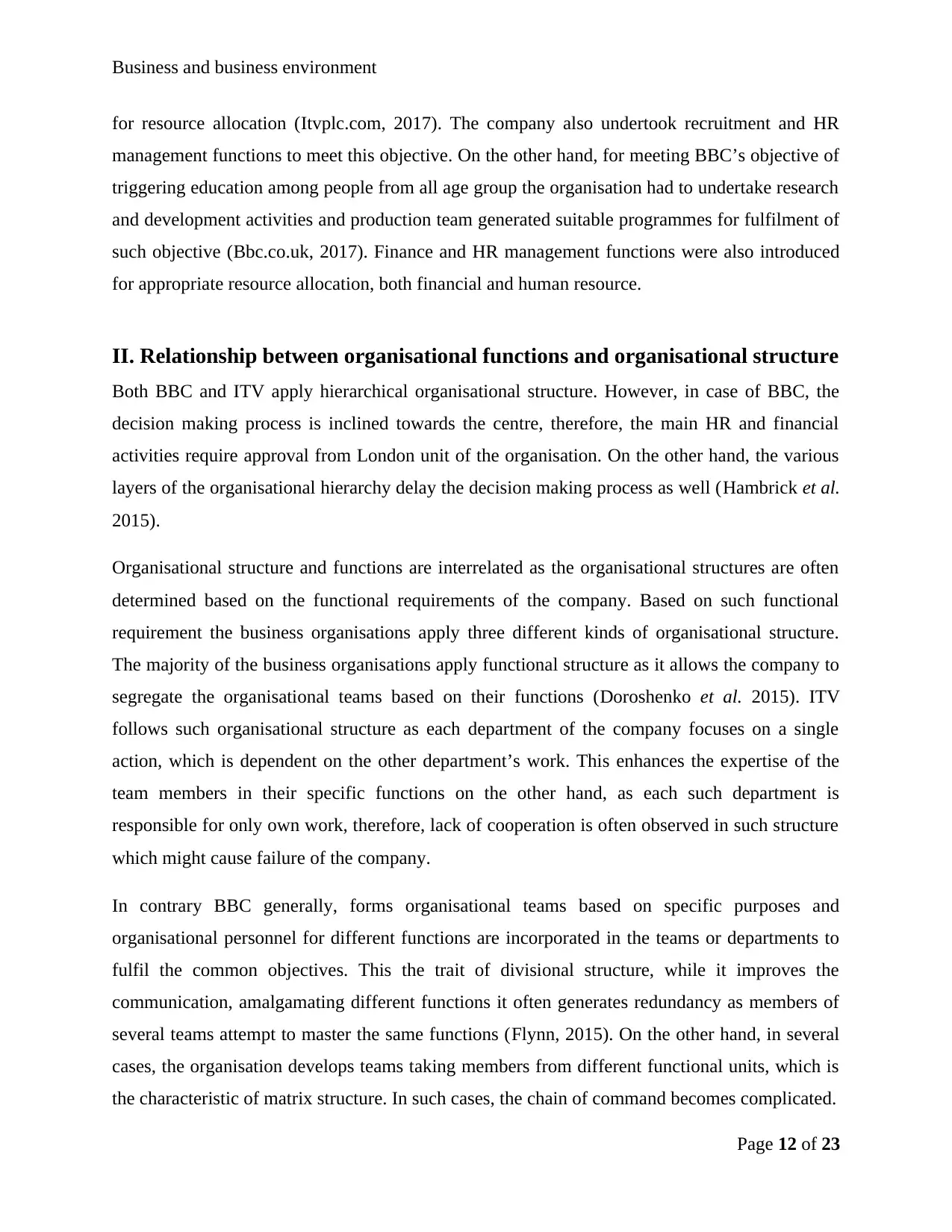
Business and business environment
for resource allocation (Itvplc.com, 2017). The company also undertook recruitment and HR
management functions to meet this objective. On the other hand, for meeting BBC’s objective of
triggering education among people from all age group the organisation had to undertake research
and development activities and production team generated suitable programmes for fulfilment of
such objective (Bbc.co.uk, 2017). Finance and HR management functions were also introduced
for appropriate resource allocation, both financial and human resource.
II. Relationship between organisational functions and organisational structure
Both BBC and ITV apply hierarchical organisational structure. However, in case of BBC, the
decision making process is inclined towards the centre, therefore, the main HR and financial
activities require approval from London unit of the organisation. On the other hand, the various
layers of the organisational hierarchy delay the decision making process as well (Hambrick et al.
2015).
Organisational structure and functions are interrelated as the organisational structures are often
determined based on the functional requirements of the company. Based on such functional
requirement the business organisations apply three different kinds of organisational structure.
The majority of the business organisations apply functional structure as it allows the company to
segregate the organisational teams based on their functions (Doroshenko et al. 2015). ITV
follows such organisational structure as each department of the company focuses on a single
action, which is dependent on the other department’s work. This enhances the expertise of the
team members in their specific functions on the other hand, as each such department is
responsible for only own work, therefore, lack of cooperation is often observed in such structure
which might cause failure of the company.
In contrary BBC generally, forms organisational teams based on specific purposes and
organisational personnel for different functions are incorporated in the teams or departments to
fulfil the common objectives. This the trait of divisional structure, while it improves the
communication, amalgamating different functions it often generates redundancy as members of
several teams attempt to master the same functions (Flynn, 2015). On the other hand, in several
cases, the organisation develops teams taking members from different functional units, which is
the characteristic of matrix structure. In such cases, the chain of command becomes complicated.
Page 12 of 23
for resource allocation (Itvplc.com, 2017). The company also undertook recruitment and HR
management functions to meet this objective. On the other hand, for meeting BBC’s objective of
triggering education among people from all age group the organisation had to undertake research
and development activities and production team generated suitable programmes for fulfilment of
such objective (Bbc.co.uk, 2017). Finance and HR management functions were also introduced
for appropriate resource allocation, both financial and human resource.
II. Relationship between organisational functions and organisational structure
Both BBC and ITV apply hierarchical organisational structure. However, in case of BBC, the
decision making process is inclined towards the centre, therefore, the main HR and financial
activities require approval from London unit of the organisation. On the other hand, the various
layers of the organisational hierarchy delay the decision making process as well (Hambrick et al.
2015).
Organisational structure and functions are interrelated as the organisational structures are often
determined based on the functional requirements of the company. Based on such functional
requirement the business organisations apply three different kinds of organisational structure.
The majority of the business organisations apply functional structure as it allows the company to
segregate the organisational teams based on their functions (Doroshenko et al. 2015). ITV
follows such organisational structure as each department of the company focuses on a single
action, which is dependent on the other department’s work. This enhances the expertise of the
team members in their specific functions on the other hand, as each such department is
responsible for only own work, therefore, lack of cooperation is often observed in such structure
which might cause failure of the company.
In contrary BBC generally, forms organisational teams based on specific purposes and
organisational personnel for different functions are incorporated in the teams or departments to
fulfil the common objectives. This the trait of divisional structure, while it improves the
communication, amalgamating different functions it often generates redundancy as members of
several teams attempt to master the same functions (Flynn, 2015). On the other hand, in several
cases, the organisation develops teams taking members from different functional units, which is
the characteristic of matrix structure. In such cases, the chain of command becomes complicated.
Page 12 of 23
⊘ This is a preview!⊘
Do you want full access?
Subscribe today to unlock all pages.

Trusted by 1+ million students worldwide
1 out of 22
Related Documents
Your All-in-One AI-Powered Toolkit for Academic Success.
+13062052269
info@desklib.com
Available 24*7 on WhatsApp / Email
![[object Object]](/_next/static/media/star-bottom.7253800d.svg)
Unlock your academic potential
Copyright © 2020–2025 A2Z Services. All Rights Reserved. Developed and managed by ZUCOL.





